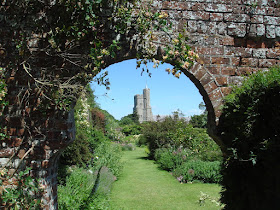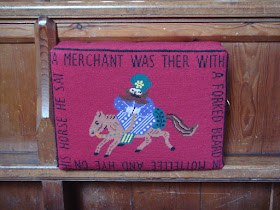
There are two lovely churches in Kent which have special connections to Jane Austen. They have similar names: Godmersham and Goodnestone (pronounced 'Gunston', and not to be confused with the Goodnestone which is near Faversham and which has its own delightful church). I've been to Godmersham only once, Goodnestone many times, most recently this time last year - and it was so lovely that the return of Easter has reminded me of it, and made me want to post about it.
But Godmersham first, because I have a little less to say about that. The house at Godmersham, which is about half way between Canterbury and Ashford, was the residence of Jane Austen's brother Edward. The house now belongs to the Association of British Dispensing Opticians (which always sounds to me like the beginning of a joke) and you can't visit it, though you have to drive through their drive, as it were, to get to the church.

The church (dedicated to St Lawrence) is a Saxon foundation; Godmersham belonged to the Archbishop of Canterbury at the time of Domesday Book, and that's usually a guarantee of an ancient, well-built church. Which this is. It's got some interesting medieval things, including this blocked doorway:

And a twelfth-century carving of a bishop who is probably Thomas Becket, given that every bishop in the vicinity of Canterbury tends to be identified as Thomas Becket:

But we came here for the Jane Austen connection, and here it is:

"In the family vault beneath are deposited the remains of Edward Knight of Godmersham Park and of Chawton House in the county of Southampton, Esq., who departed this life Nov. 19th 1852, in the 86th year of his age. Mr Knight, whose paternal name was Austen, succeeded by will in 1794 to the estates of his cousin Thomas Knight Esq., and on the death of his widow in 1812 assumed the name and arms of Knight."
"In the same vault is buried Elizabeth his wife, third daughter of Sir Brook Bridges of Goodnestone Park".
That nicely explains how the two churches of this post fit together. Jane Austen often visited her brother in Kent and worshipped at this church while staying at Godmersham. The interior would have looked a little different in her day, pre-Victorian restoration:

And before the adding of curtains and tasteful blue cupboards (which create a pretty, light kind of effect when you enter):


The day I went there the church was full of flowers, because a wedding had just finished. What's more Jane Austen-like than a wedding? Everyone looked very happy; and Jane did say after all that "Kent is the only place for happiness; everybody is rich there."

This certainly feels like a well-cared for, prosperous kind of church. I was taken with this little tribute to Chaucer's pilgrims, of course:

Godmersham's past vicars include the antiquary Samuel Pegge, who is known to me for being the first person to question the historicity of Guy of Warwick. Good work, Pegge. But that was before Jane's day.

And now to Goodnestone, which has a special place in my heart. The connection with Jane Austen is arguably weaker than at Godmersham - though she certainly did stay at the house and visit the church - but it would still be one of the most delightful spots on earth even if Jane Austen had never set foot there.

You can't visit the house (except for special events) but the gardens are open to the public. And when I say 'open to the public' I don't mean in a National Trust way, with slick gift shops and busy cafes and staff rushed off their feet - I mean in the most charming, low-key, personal way possible. It's utterly uncommercial and yet the best value for money you'll get anywhere in Kent. Let's imagine I'm taking you on a tour. So we wander around, and look at the house from various angles:

And wonder from which direction Jane Austen approached it, and which Austen house it's most like (too small for Rosings, too grand for Longbourn, but I always imagine Hartfield or Mansfield Park being just like this):


These pictures were from a visit in June (of 2008), which explains the blue sky and the abundance of flowers in the walled garden:

Isn't 'walled garden' one of the most enchanting phrases in the English language?

From this garden the tower of the church, just beyond the garden wall, forms the perfect backdrop to the scene:

This may be the most English vista you will ever see!

I know approximately nothing about flowers (I can usually identify a rose and a lily, and that's about it). Gardeners seem to approve of Goodnestone's, though I can only tell you that they're very bright and very pretty, and surrounded by green lawns and hedges and other lovely things.


So we wander around among the flowers for a while, and then we find a bench and sit down, and reflect that 'To sit in the shade on a fine day and look upon verdure is the most perfect refreshment'.


Then we leave the walled garden, and find ponds with dragon-flies:

We try to think of something to connect Jane Austen and dragon-flies, and fail to find anything...
The walled garden is best in the summer, but if we happen to be here in spring, there's plenty in the way of blossom and bluebells:



These pictures are from last Easter, during a Bank Holiday heatwave, when the pink blossom (of some kind... I'm not much better with trees than with flowers) fell scattered across the formal garden at the front of the house.

The house looks out over parkland, and the village cricket pitch, where you'll sometimes see a game going on.

Mention of the village reminds me that this post was supposed to be about the church. House and church and estate cottages all sit cosily together, and when we've finished our leisurely stroll through the gardens we wander over to the church, by which time the sun is probably beginning to slant into the west.


I used pictures from Goodnestone church to illustrate my post on Thomas Hardy's 'A Church Romance', with its 'sinking sad tower window light', but there's nothing sad about the afternoon light at Goodnestone; it's quiet and calm and contented, a happy church taking its peaceful rest.

The nave, restored in the nineteenth century (after Jane's time), is elegant and light, with 'frozen fountains playing' of pillars and arches.

Some things Jane would recognise: presumably this memorial to local philanthropist Gabriel Richards, who died in 1672, was there when she came.

I like this because you don't see much Greek on church monuments! 'The Charity of Gabriel Richards, otherwise known as Goodnestone Hospital' seems to exist to this day.
Other ancient things include some medieval stained glass:

St Michael, of course, and a bishop who always looks to me as if he's waving:

(It's actually a gesture of blessing). More bishops:

And the light they cast:

A recent memorial in the north aisle tells of the generosity of the last owner of Goodnestone Park in 'restoring and beautifying this ancient church'. This seems to me a perfect illustration of the ideal relationship between village and great house, between Colonel Brandon at the hall and Elinor and Edward at the parsonage - or the idyll which Fanny and Edmund would have made for themselves at Mansfield Park.

Since our tour takes place after Easter, there are flowers here too.

Beautiful!
ReplyDeleteAgreed. Lovely pictures.
ReplyDelete